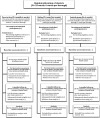Nurture Early for Optimal Nutrition (NEON) participatory learning and action women's groups to improve infant feeding and practices in South Asian infants: pilot randomised trial study protocol
- PMID: 38030249
- PMCID: PMC10689384
- DOI: 10.1136/bmjopen-2022-063885
Nurture Early for Optimal Nutrition (NEON) participatory learning and action women's groups to improve infant feeding and practices in South Asian infants: pilot randomised trial study protocol
Abstract
Introduction: Feeding practices developed in early life can impact a child's nutrition, growth, dental health, cognitive development and lifetime risk of chronic diseases. Substantial evidence suggests ethnic health inequalities, and non-recommended complementary infant feeding practices among UK's South Asian (SA) population. Nurture Early for Optimal Nutrition aims to use women's group participatory learning and action (PLA) cycles to optimise infant feeding, care and dental hygiene practices in SA infants <2 years in East London.
Methods and analysis: A three-arm pilot feasibility cluster randomised controlled trial will assess feasibility, acceptability, costs and explore preliminary effectiveness for proposed primary outcome (ie, reporting on body mass index (BMI) z-score). Multilingual SA community facilitators will deliver the intervention, group PLA Cycle, to mothers/carers in respective ethnic/language groups. 12 wards are randomised to face-to-face PLA, online PLA and usual care arms in 1:1:1 ratio. Primary outcomes are feasibility and process measures (ie, BMI z-score, study records, feedback questionnaires, direct observation of intervention and sustainability) for assessment against Go/Stop criteria. Secondary outcomes are cluster-level and economic outcomes (ie, eating behaviour, parental feeding practices, network diffusion, children development performance, level of dental caries, general practitioner utilisation, costs, staff time). Outcomes are measured at baseline, every 2 weeks during intervention, 14 weeks and at 6 months by blinded outcome assessors where possible. This study will use concurrent mixed-methods evaluation. Quantitative analyses include descriptive summary with 95% CI and sample size calculation for the definitive trial. The intervention effect with CI will be estimated for child BMI z-score. Implementation will be evaluated qualitatively using thematic framework analysis.
Ethics and dissemination: Ethics approval was obtained from University College London (UCL), National Health Service (Health Research Authority (HRA) and Health and Care Research Wales (HRCW)). Results will be published in peer-reviewed journals, presented at scientific conferences/workshops with commissioners, partners and participating communities. Plain language summaries will be disseminated through community groups, websites and social media.
Trial registration number: IRAS-ID-296259 (ISRCTN10234623).
Keywords: Community child health; NUTRITION & DIETETICS; PAEDIATRICS; PUBLIC HEALTH.
© Author(s) (or their employer(s)) 2023. Re-use permitted under CC BY. Published by BMJ.
Conflict of interest statement
Competing interests: None declared.
Figures



References
-
- World Health Organization (WHO) . Postnatal care for mothers and newborns: highlights from the world health organization 2013 guidelines; 2015. 4. Available: http://www.who.int/maternal_child_adolescent/publications/WHOMCA-PNC-201...
-
- Brown MS. Religion and economic activity in the South Asian population. Ethnic and Racial Studies 2000;23:1035–61. 10.1080/014198700750018405 - DOI
-
- ASQ-3 . The ages & stages questionnaires, 3rd ed. Available: https://agesandstages.com/products-pricing/asq3 [Accessed 30 Nov 2019].
Publication types
MeSH terms
Substances
LinkOut - more resources
Full Text Sources
Medical
